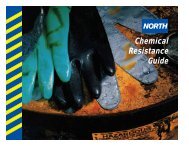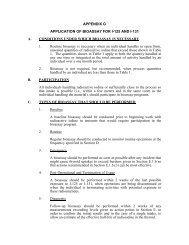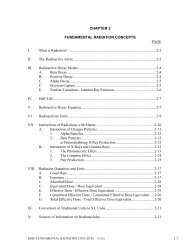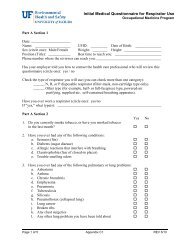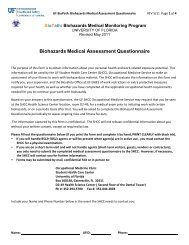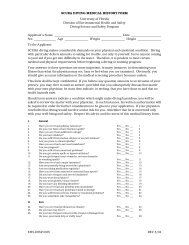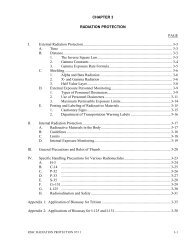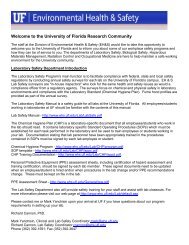Biological Safety Manual - University of Florida
Biological Safety Manual - University of Florida
Biological Safety Manual - University of Florida
Create successful ePaper yourself
Turn your PDF publications into a flip-book with our unique Google optimized e-Paper software.
Gloves or other disposable personal protective equipment from clinical or biomedical labs that areNOT contaminated with any <strong>of</strong> the biological wastes listed in Infectious, Potentially Infectious orRecombinant or Synthetic Nucleic Acid <strong>Biological</strong> Waste category above and not contaminatedwith hazardous chemicals.Blood, blood products, tissues, or items contaminated with these, from animals not known to, orexpected to, contain pathogens.This waste does not require inactivation before it leaves the facility. Place this waste in the red bag-linedcardboard biological waste box for disposal.Sharps WasteInstruments are those that are intended to cut or penetrate skin (e.g., metal lancets, scalpel blades,needles, or syringe/needle combinations) must be placed in red, hard plastic sharps boxes, even ifunused. The sharps box should be closed when it is ¾ full and discarded within 30 days after closure.Sharps boxes are placed into the red bag-lined cardboard biological waste box for disposal. Ifcontaminated with infectious, potentially infectious, or recombinant or synthetic nucleic acid, the sharpsbox must be autoclaved before disposal.Instruments that can cut skin, but are not intended to do so (fragile glass, glass slides and cover slips,razor blades, pipettes and pipette tips), should be disposed <strong>of</strong> in a manner that prevents harm. Use: Sharps Box (date when first placed into use and dispose within 30 days <strong>of</strong> first use). Small rigid box that is then placed in a biohazard bag. Plastic sleeve (to hold the pipettes together in a bundle) that is then placed in a biohazard bag. If contaminated with infectious, potentially infectious, or recombinant or synthetic nucleic acid, thematerial must be inactivated before disposal.Mixed Radioactive/<strong>Biological</strong> WasteThe infectious, potentially infectious, or recombinant or synthetic nucleic acid component(s) <strong>of</strong> mixedradioactive/biohazardous waste shall be inactivated (if possible) prior to its release to Radiation <strong>Safety</strong>Services for disposal as radioactive waste. Please contact the Radiation <strong>Safety</strong> Office (392-7359)regarding the best method <strong>of</strong> inactivation.Mixed chemical/biological wasteThe infectious, potentially infectious, or recombinant or synthetic nucleic acid component(s) <strong>of</strong> mixedchemical/biohazardous waste shall be inactivated (if possible) prior to turning it over to EH&S HazardousMaterials Management for chemical disposal. Precautions should be taken to prevent the generation andrelease <strong>of</strong> toxic chemicals during the inactivation process. In general, autoclaving is not recommended.Note that the chemical component <strong>of</strong> the waste may inactivate the biohazard (e.g. as in the case <strong>of</strong>fixative solutions). Please contact the Hazardous Materials Management Facility at 352-392-8400 or theBiosafety Office (392-1591) for guidance regarding particular chemicals. Chemical waste must besegregated, stored, labeled, and handled per the requirements outlined in the Chemical WasteManagement Guide.Human Remains/TissuesContact the Biosafety Office (352) 392-1591 or the State Anatomical Review Board (352) 392-3588 forinformation. Off campus facilities should contact the Biosafety Office at (352) 392-1591 for guidance.<strong>Biological</strong> Waste Packing, Labeling, & TransportThe transport <strong>of</strong> biohazardous waste outside <strong>of</strong> the lab (i.e. to an autoclave or incinerator) must be in aclosed, leak-pro<strong>of</strong> bag or container; bags must be contained in a leak pro<strong>of</strong> tray and transported on a cartto and from the autoclave. Do not leave non-inactivated waste unattended. Laboratory staff needing totransport properly packaged and labeled biowaste boxes to a secure storage/pick up area must protectthe boxes from the weather and not leave the boxes unattended. For those laboratories that do not havean established routine pickup or an established secure storage/pick up area in the facility, the following isrequired for transporting Biomedical Waste to the loading dock <strong>of</strong> the Health Science Center for disposal: A state vehicle is required for transport, not a personal vehicle. Must move less than 25 lbs. at a time (I box). The locked silver Semi Trailer at the loading dock <strong>of</strong> the Health Center is the disposal site.43




